Exercises (1559)
Lowering and raising the upper body while standing
Power
Individual work


Stand with your feet shoulder-width apart and hold the gymnastics pole on your shoulders behind your head. Your feet are in the loops, your knees are slightly bent and your upper body is leaning forwards with a straight back. Bend your upper body and roll back up to the starting position.
Attention:
The pelvis remains stable and should not move, so try to straighten your upper body vertebra by vertebra.
Lighten:
Choose less strong elastic bands; roll up the elastic bands less.
Harden:
Choose stronger elastic bands; roll up the elastic bands more.
Variation:
Hold the gymnastics bar at knee height with outstretched arms instead of on your shoulders.
1 gymnastic bar with elasticated straps
Lowering and raising the upper body while standing
Power
Individual work

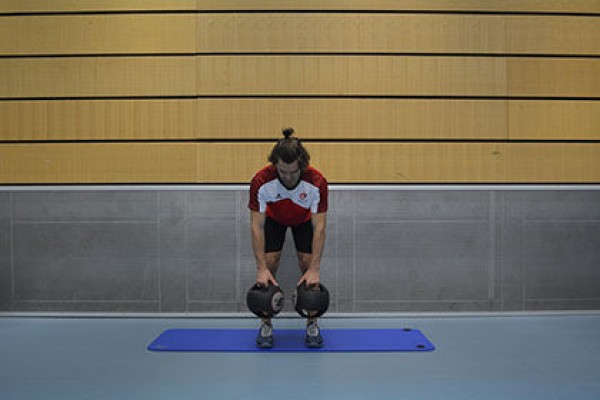
Stand upright, shoulder-width apart, hold a dumbbell/kettlebell in each hand in front of your body at hip height (backs of hands pointing forwards), tilt your upper body forwards with a straight back and move the weight towards your shins. Lower the weight as far as you can keep your back straight before raising your upper body back to the starting position.
Attention:
The movement takes place in the hip joint, move the weight close to the body, keep your back straight.
Lighten:
Less weight or no weight at all.
Harden:
More weight.
2 dumbbells/kettlebells
Lowering and raising the upper body while standing (left) ► windmill
Power
Individual work
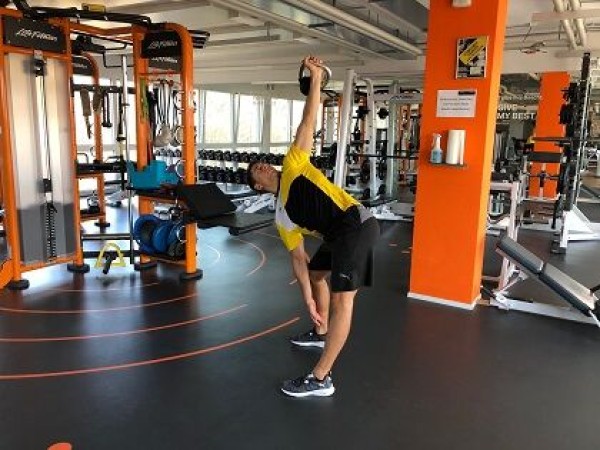

Stand upright with the weight (dumbbell or kettlebell) with one arm (left) stretched out overhead (arm almost stretched out in an upright position), bend the leg (right - opposite side of the hand with the weight) and push the buttocks backwards without losing stability in the back, always looking towards the weight and finally lowering the upper body down/leaning forwards at an angle. The free arm (right) is brought crosswise to the shin of the extended leg (left). Then work the weight out of the torso in a controlled manner and push it back up to the upright starting position.
Starting position:
- Stand upright, shoulder-width apart
- Stabilise the weight with one arm overhead in a high position
- Tense the abdominal and gluteal muscles
- Look forwards
Finishing position:
- One leg extended, the other slightly bent (opposite side of the hand with the weight)
- Buttocks pushed backwards
- Upper body lowered/inclined forwards, free arm touches the shin crosswise
- Back remains straight
- Gaze directed towards the weight
Attention:
This exercise places high demands on mobility and stability, which is why it is only suitable for experienced exercisers.
1 dumbbell/kettlebell
Lowering and raising the upper body while standing (right) ► windmill
Power
Individual work
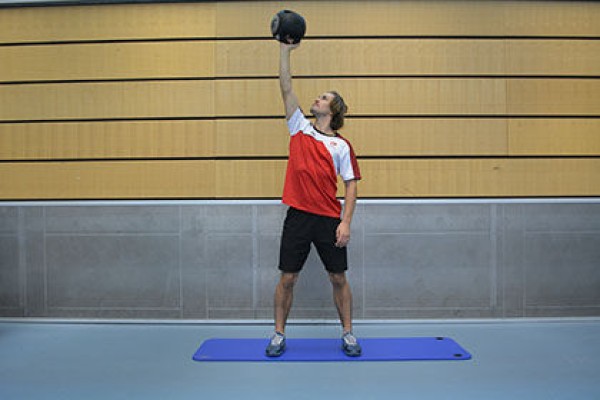
Stand upright with the weight (dumbbell or kettlebell) with one arm (right) stretched out overhead (arm almost stretched out in an upright position), bend the leg (left - opposite side of the hand with the weight) and push the buttocks backwards without losing stability in the back, always looking towards the weight and finally lowering the upper body down/leaning forwards at an angle. The free arm (left) is brought crosswise to the shin of the extended leg (right). Then work the weight out of the torso in a controlled manner and push it back up to the upright starting position.
Starting position:
- Stand upright, shoulder-width apart
- Stabilise the weight with one arm overhead in an upright position
- Tense the abdominal and gluteal muscles
- Look forward
Finishing position:
- One leg extended, the other slightly bent (opposite side of the hand with the weight)
- Buttocks pushed backwards
- Upper body lowered/inclined forwards, free arm touches the shin crosswise
- Back remains straight
- Gaze directed towards the weight
Attention:
This exercise places high demands on mobility and stability, which is why it is only suitable for experienced exercisers.
1 dumbbell/kettlebell
Lowering and raising the upper body while standing ► romanian deadlift
Power
Individual work
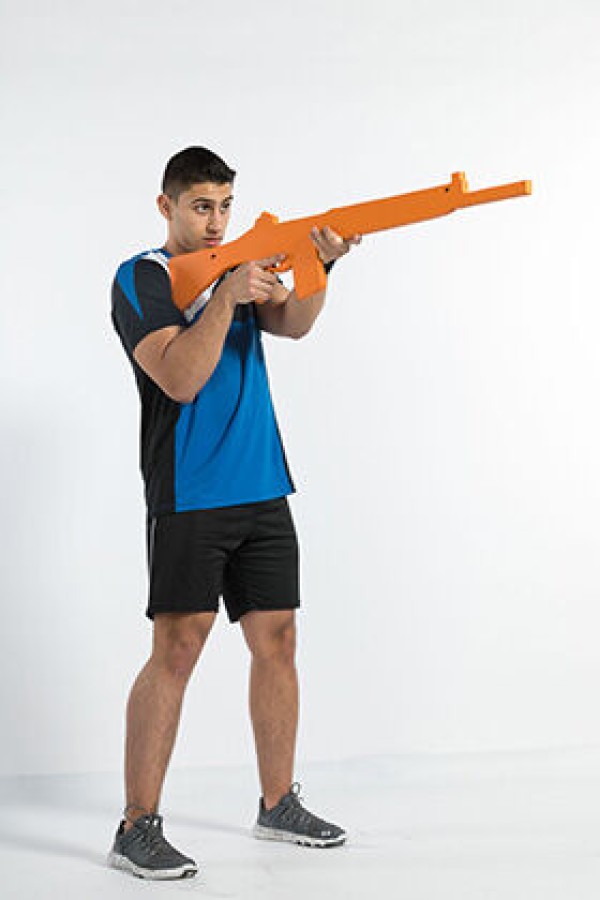

Start standing, bend your upper body so that the barrel of the rifle is pointing towards the ground and return to the starting position.
Lighten:
Bend/lower your upper body less.
1 assault rifle (neutralised)
Lowering and raising the upper body in prone position (hip and back extension) ► ghd hip and back extension
Power
Individual work
Place the thighs on the padding and fix the feet in the holder (feet pointing downwards). Make sure that the support pad is adjusted so that the hips are free and the legs are straight. The hips are extended, the exposed upper body is kept horizontal and the arms are held on the chest or crossed. From this position, lower the upper body, first lowering/tilting the chin towards the chest before starting to bend the spine in the neck. The upper back is then rolled up, followed by the lower back. Finally, the hips are flexed and the spine is briefly stretched. Once in the end position, the hips are stretched first in reverse order, while the spine is flexed. The hips remain stretched as the lower back and then the upper back are stretched. With a neutral spine and stretched hips, return to the starting position (upper body horizontal to the floor).
Caution:
Consciously curl or uncurl your back vertebra by vertebra.
Lighten:
-
Lighten:
Additional weight (on the chest)
1 glute-ham developer (GHD)
1 weight disc ►to make the exercise more difficult (additional weight)
Lowering and raising the upper body in prone position ► ghd back extension
Power
Individual work
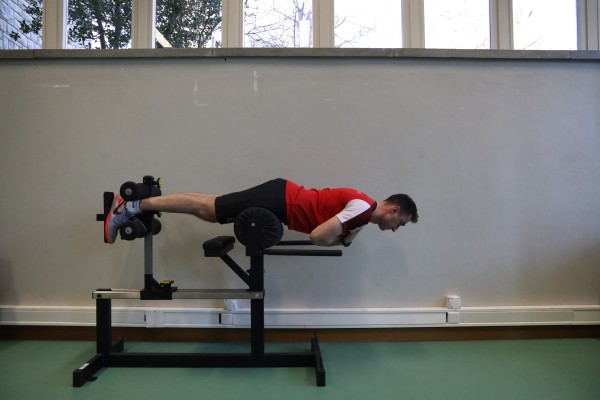
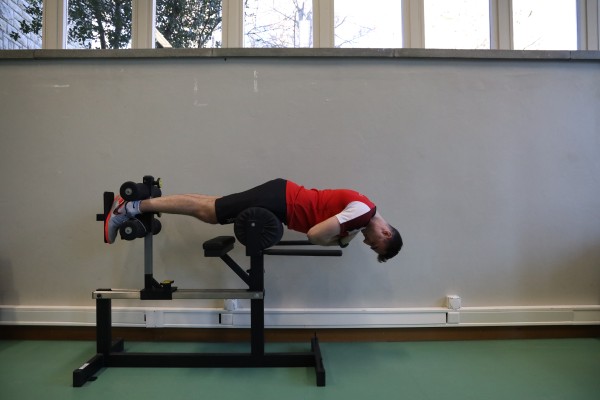
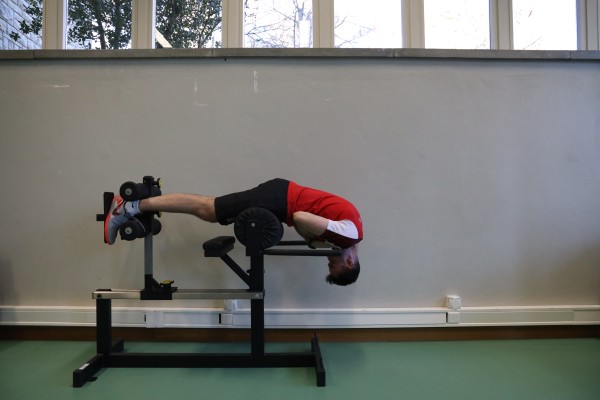
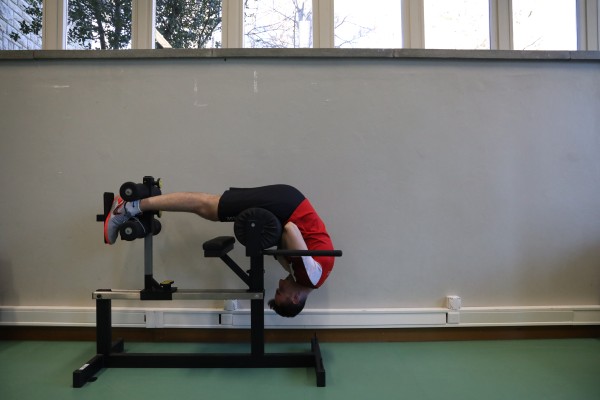
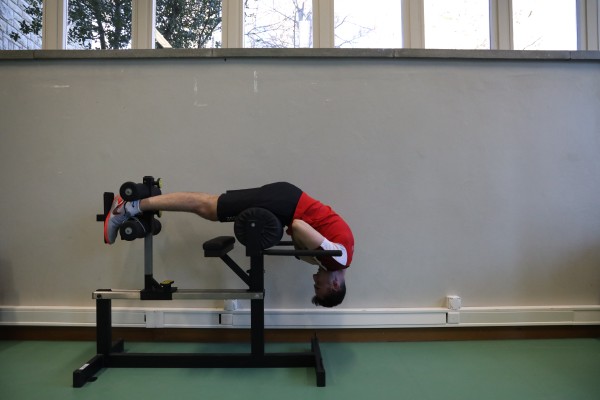
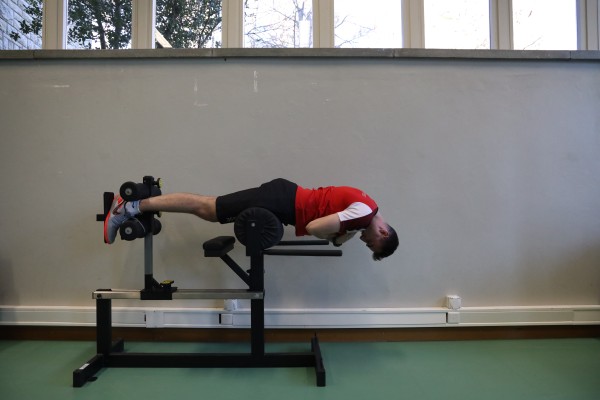
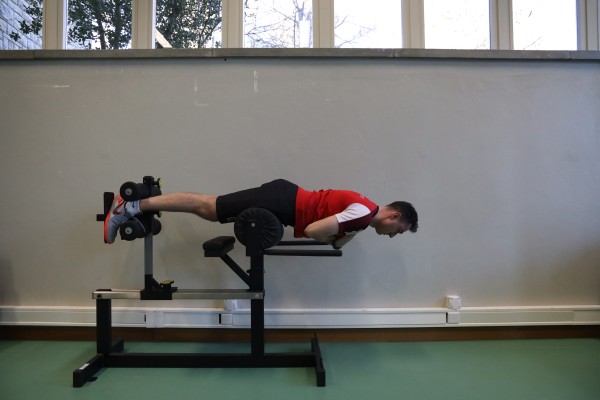
Place your hips on the padding and fix your feet in the holder with your legs stretched out (feet pointing downwards). The hips are stretched, the exposed upper body is held horizontally with a neutral spine, the arms are held on the chest or crossed. From this position, lower the upper body, first lowering/tilting the chin towards the chest before starting to bend the spine in the neck. The upper back is then rolled up, followed by the lower back. Once in the final position, the back is rolled up again in reverse order to return to the starting position with a neutral spine (first stretch the lower back, then the upper back and finally the neck).
Attention:
Consciously roll your back in or up vertebra by vertebra.
Lighten:
-
Harden:
Additional weight (on the chest).
1 glute-ham developer (GHD)
1 weight disc ► to make the exercise more difficult (additional weight)
Lowering and raising the upper body in prone position ► ghd hip extension
Power
Individual work
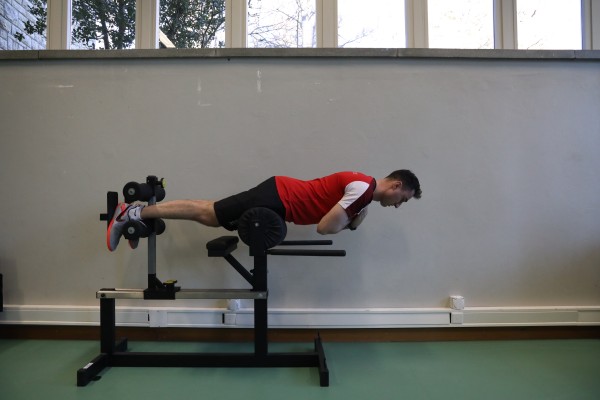
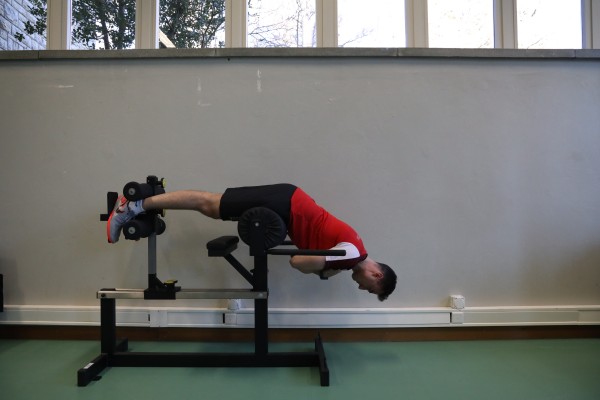
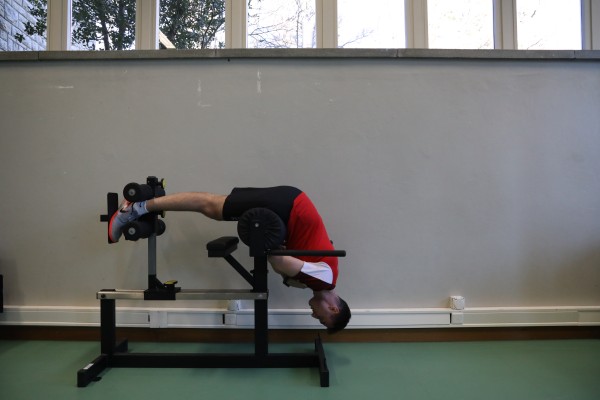
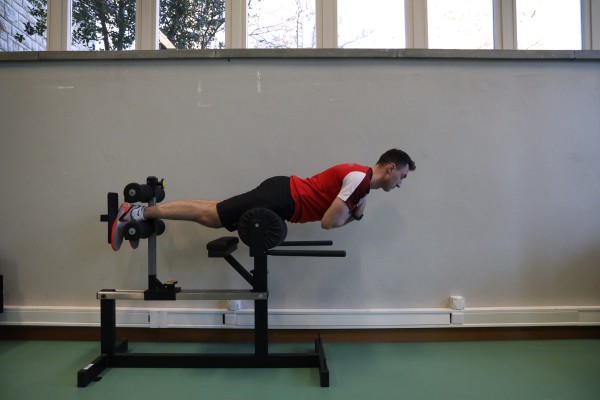
Place the thighs on the padding and fix the feet in the holder (feet pointing downwards). Make sure that the support pad is adjusted so that the hips are free and the legs are straight. The hips are extended, the exposed upper body is kept horizontal and the arms are held on the chest or crossed. From this position, bend the hips as far as possible (while maintaining the lumbar curve). The return to the starting position is initiated by tensing the gluteal muscles and hamstrings. Finally, the upper body is raised again until the hips are fully extended (upper body horizontal to the floor).
Attention:
The position of the upper body remains unchanged (keep the torso tensed).
Lighten:
Lower the upper body less; support from a partner; place a raised object underneath the upper body to support yourself with your hands.
Harden:
Additional weight (on the chest); place hands with bent arms by the ears; arms held high (extension of the body).
1 glute-ham developer (GHD)
1 plyo box/crate etc. ► Make the exercise easier (raised base)
1 weight disc ► Make the exercise more difficult (additional weight)
Lowering and raising the upper body in a kneeling position ► barbell ab roll
Power
Individual work


Stand on four feet with your legs slightly raised (and possibly crossed). Support your upper body with both hands slightly more than shoulder-width apart on a barbell (possibly with weight discs for better rolling). Roll the barbell forwards (arms extended above your head) and back to the starting position (lower and raise your upper body).
Attention:
Do not fall into a hollow back (only roll forwards as far as you can maintain the tension), actively tense your core.
Lighten:
Lower your arms (lower your upper body less).
Harden:
Add weight (on your shoulders); wedge the medicine ball between your buttocks and heels with your legs; raise your knees.
1 barbell
1 weight vest/weight disc/sandbag ► Make the exercise more difficult (additional weight)
Lowering and raising the upper body in a kneeling position ► rollout
Power
Individual work
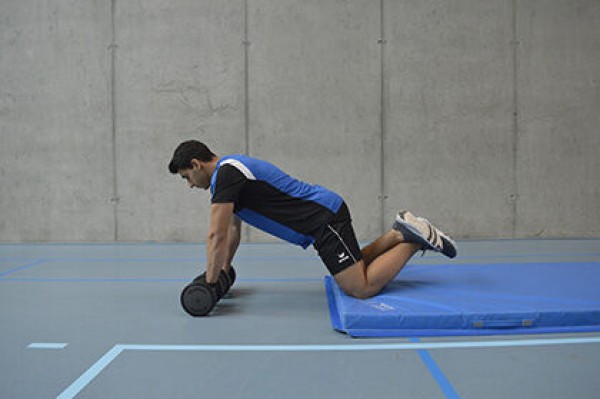

Stand on four feet with your legs slightly raised and crossed. Support your upper body on (2) dumbbells. Roll the dumbbells forwards (arms extended above your head) and back to the starting position (lower and raise your upper body).
Attention:
Do not fall into a hollow back (only roll forwards as far as you can maintain the tension), actively tense your core.
Lighten:
Lower your arms forward (lower your upper body less).
Harden:
Add weight (on your shoulders); wedge the medicine ball between your buttocks and heels with your legs; lift your knees.
2 dumbbells
1 weight vest/weight disc/sandbag ► Make the exercise more difficult (additional weight)
Lowering and raising the upper body in a kneeling position ► rollout
Power
Individual work
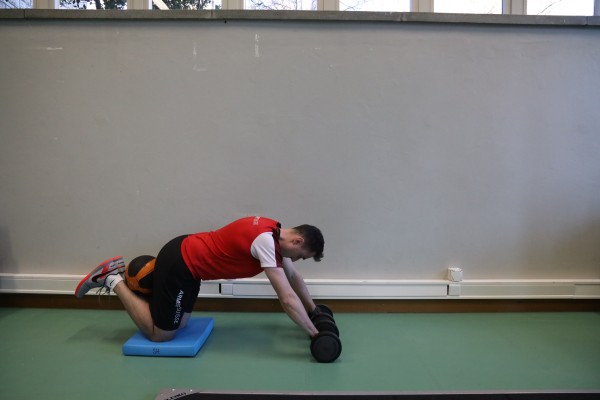

Stand on four feet with your legs slightly raised, clamping a medicine ball between your buttocks and heels and supporting your upper body on two dumbbells. Roll the dumbbells forwards (arms extended above your head) and back to the starting position (lower and raise your upper body).
Attention:
Do not fall into a hollow back (only roll forwards as far as you can maintain the tension), actively tense your core.
Lighten:
Lower your arms (lower your upper body less); perform the exercise without a medicine ball.
Harden:
Add weight (on your shoulders); raise your knees.
2 dumbbells
1 medicine ball
1 weight vest/weight disc/sandbag ► Make the exercise more difficult (additional weight)
Alternating lowering and raising of one leg in supine position ► alternating bent knee raise
Power
Individual work



Lie on your back with your upper body slightly raised (shoulder blades lifted off the floor), legs bent and held high (slightly more than 90 degrees at the knee joint, lower leg parallel to the floor), outstretched arms pointing slightly backwards at an angle, grasp the weight with both hands. Lower one leg so that the heel briefly touches the floor and return to the starting position (the angle in the knee joint remains practically unchanged). Switch sides after each exercise.
Attention:
Always keep your shoulder blades off the floor (constant tension), head in a neutral position (no double chin).
Lighten:
Hold your arms at chest height or even further forwards; do not hold any additional weight in your hands.
Harden:
Hold your arms further back at an angle; more weight.
1 weight disc
Lowering and raising one leg in shoulder position
Power
Partner work
1 trainee & 1 helper ► Note change of position
(= double the time required; for lesson planner see Organisation Kraft: Info button Execution)
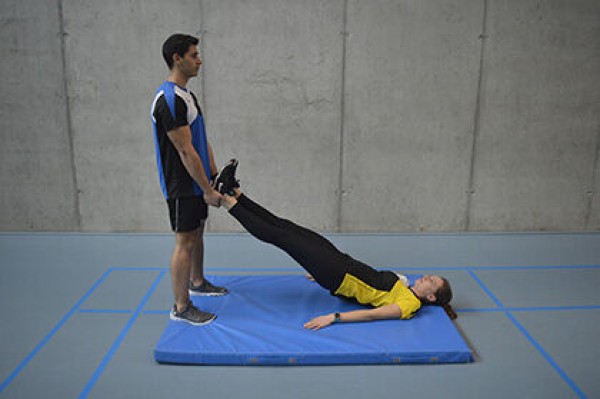
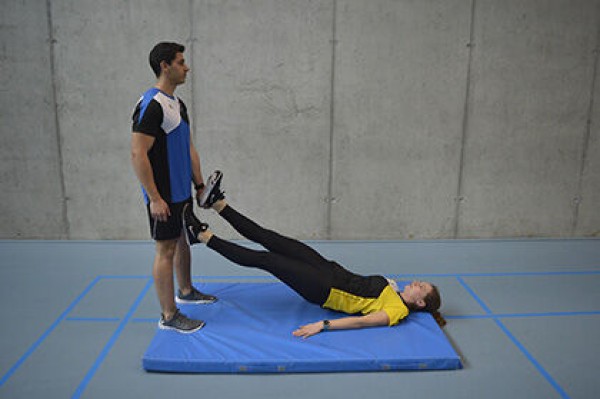
Practitioner: Shoulder position and arms at the side of the body. Slow down the leg dropped by the partner as quickly as possible and bring it back up to the starting position.
Partner: Stand upright and hold the active participant's legs at about hip height. Alternately drop one leg.
Attention:
Always listen to/respond to your partner (adjust intensity). No sagging in the hips (tense position); rest on the shoulder blades and not on the neck.
Lighten:
Just hold the position (without letting go of one leg).
Harden:
Additional weight on the legs.
Variant:
Let go of the leg unknown to the exerciser (not alternating, legs released by the partner in random order).
2 weight cuffs ► Make the exercise more difficult (additional weight)
Cross-country ski ergometer
Power
Individual work
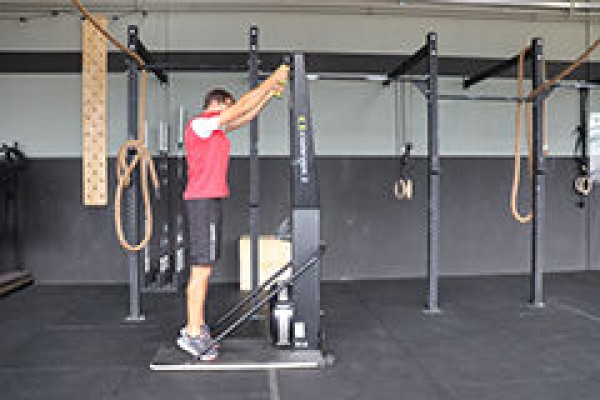
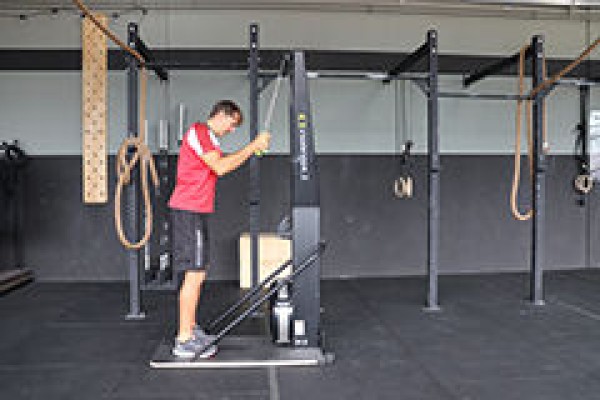

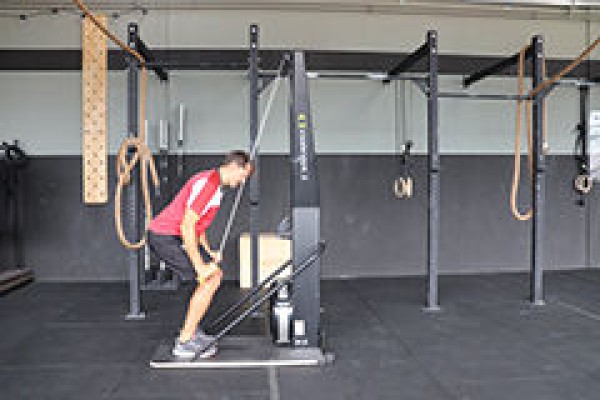


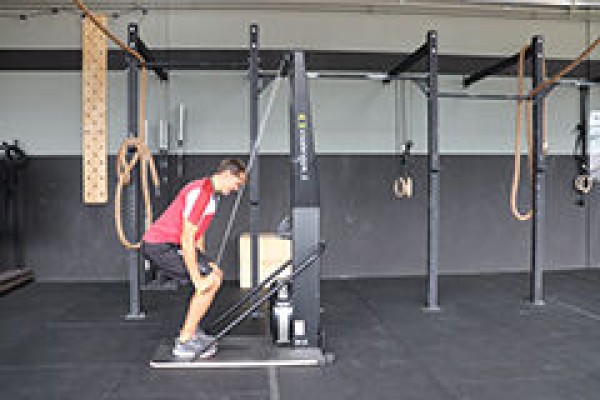
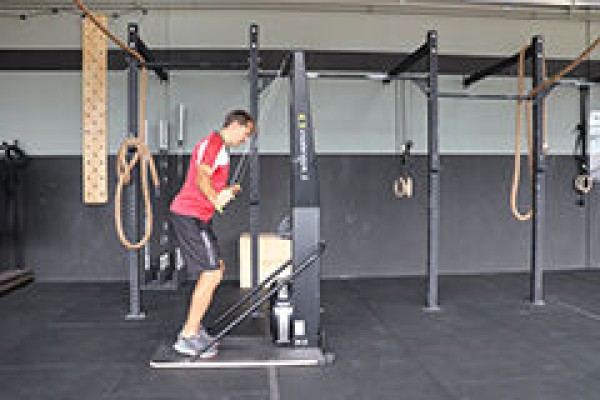
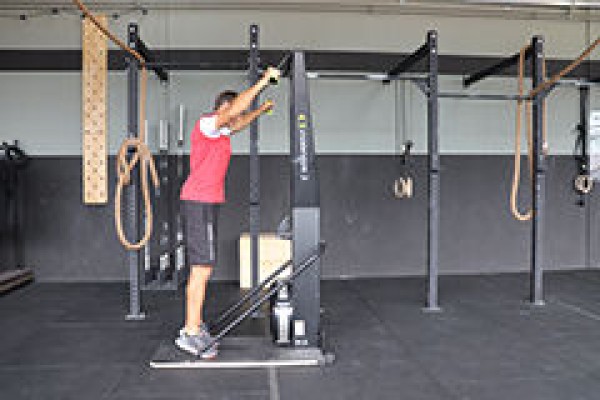
Working with the cross-country ski ergometer does not require any prior knowledge of winter sports, the technique is beginner-friendly and quick to learn. However, there are a few points to bear in mind: Firstly, stand with your feet slightly more than shoulder-width apart (how close you stand to the device is a matter of taste, although taller people usually prefer a greater distance in order to achieve a full arm extension at the starting point and therefore ultimately a longer stroke). The hands should also be just outside the shoulders when gripping the handles. As the handles of the device are attached to freely movable hinges, you can easily rotate them to your optimum position. The edges of the hand, including the little finger, should be placed on the thickened end of the handle, allowing more pressure to be applied. At the beginning of the pull, the entire body is stretched, only the arms remain slightly bent, the handles are now pulled downwards at an angle until the hands are just below the knees (a V-shaped curve, where the hands move sideways away from the body, is avoided). At the lowest point, the elbows are fully extended while the knees are minimally bent (comparable to the starting position of a jump). In the return phase, the body straightens up again completely, synchronised with the backswing of the arms. Lifting your heels off the ground is perfectly fine, especially at higher speeds.
Attention:
Do not turn every repetition into a squat, as this will tire your legs too quickly. Take a deep breath before each pull on the machine and keep the abdominal muscles under constant tension.
Lighten/Harden:
The intensity is controlled by adjusting the air valve. The higher the lever is moved on the scale (1-10), the wider the flap opens and the more air can flow into the bike. More air means more resistance in the initial phase of the pull (comparable to a higher pedalling resistance in the higher gears on a bicycle). It is important to find a setting at which a continuous and controlled pressure can be maintained. If the setting is too high, the air resistance initially has to be overcome with an excessively strong pull and the remaining range of motion "runs into nothing", which is a waste of energy. If you pay attention to the background noise, you will get a suitable indicator: the aim should be to achieve the smoothest possible whirring with only slight peaks in the initial phase of the pull. Most exercisers tend to over-optimise the resistance setting. As is so often the case, less is more; levels 6-7 work well for men and 4-6 for women, with exceptions for particularly heavy and strong athletes.
Variant:
The double pole technique is usually used for training, which means that both arms work in synchronisation with each other. The diagonal technique, in which the arms are used alternately, is less common but can be used as a variation. It achieves lower speeds than the simultaneous use of the arms, but is certainly suitable as an occasional training stimulus, which above all creates a healthy rotation of the spine and a strain on the lateral trunk muscles. The diagonal technique can also correct imbalances in unevenly developed back and arm muscles (e.g. after injuries).
1 cross-country ski ergometer
Skilanglauf-Ergometer (m: 1000m/1km - 80kal; w: 800m - 60kal)
Power
Individual work


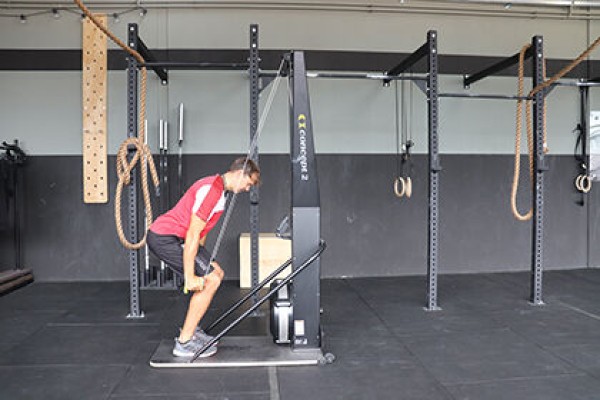
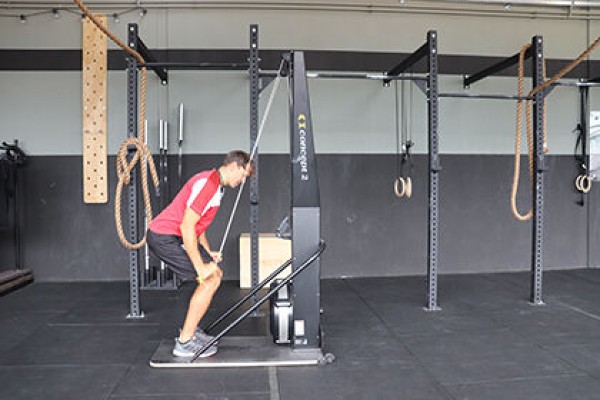
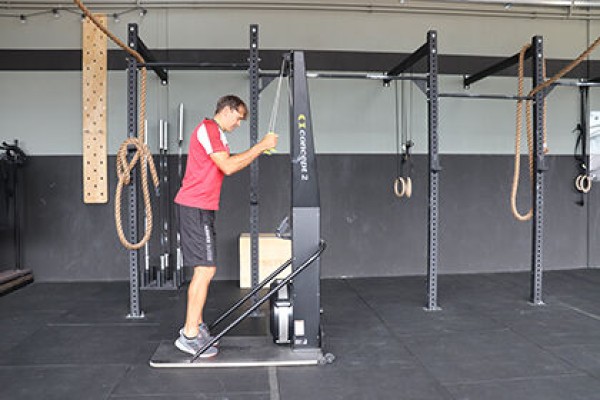
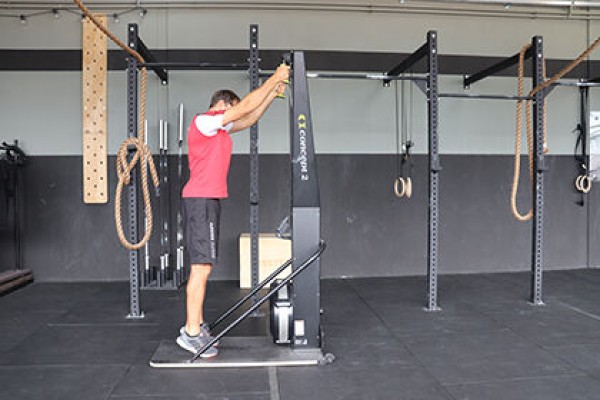


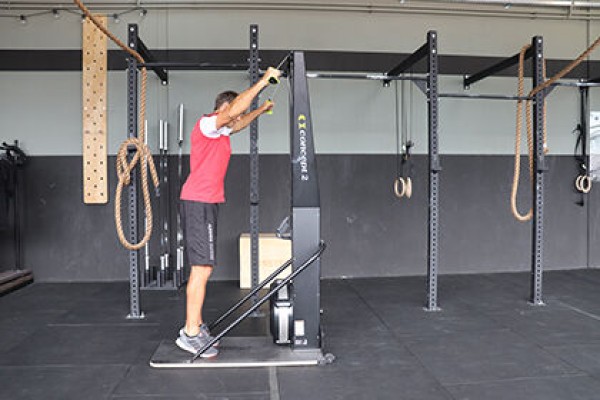
Working with the cross-country ski ergometer does not require any prior knowledge of winter sports, the technique is beginner-friendly and quick to learn. However, there are a few points to bear in mind: Firstly, stand with your feet slightly more than shoulder-width apart (how close you stand to the device is a matter of taste, although taller people usually prefer a greater distance in order to achieve a full arm extension at the starting point and therefore ultimately a longer stroke). The hands should also be just outside the shoulders when gripping the handles. As the handles of the device are attached to freely movable hinges, you can easily rotate them to your optimum position. The edges of the hand, including the little finger, should be placed on the thickened end of the handle, allowing more pressure to be applied. At the beginning of the pull, the entire body is stretched, only the arms remain slightly bent, the handles are now pulled downwards at an angle until the hands are just below the knees (a V-shaped curve, where the hands move sideways away from the body, is avoided). At the lowest point, the elbows are fully extended while the knees are minimally bent (comparable to the starting position of a jump). In the return phase, the body straightens up again completely, synchronised with the backswing of the arms. Lifting your heels off the ground is perfectly fine, especially at higher speeds.
Attention:
Do not turn every repetition into a squat, as this will tire your legs too quickly. Take a deep breath before each pull on the machine and keep the abdominal muscles under constant tension.
Lighten/Harden:
The intensity is controlled by adjusting the air valve. The higher the lever is moved on the scale (1-10), the wider the flap opens and the more air can flow into the bike. More air means more resistance in the initial phase of the pull (comparable to a higher pedalling resistance in the higher gears on a bicycle). It is important to find a setting at which a continuous and controlled pressure can be maintained. If the setting is too high, the air resistance initially has to be overcome with an excessively strong pull and the remaining range of motion "runs into nothing", which is a waste of energy. If you pay attention to the background noise, you will get a suitable indicator: the aim should be to achieve the smoothest possible whirring with only slight peaks in the initial phase of the pull. Most exercisers tend to over-optimise the resistance setting. As is so often the case, less is more; levels 6-7 work well for men and 4-6 for women, with exceptions for particularly heavy and strong athletes.
Variant:
The double pole technique is usually used for training, which means that both arms work in synchronisation with each other. The diagonal technique, in which the arms are used alternately, is less common but can be used as a variation. It achieves lower speeds than the simultaneous use of the arms, but is certainly suitable as an occasional training stimulus, which above all creates a healthy rotation of the spine and a strain on the lateral trunk muscles. The diagonal technique can also correct imbalances in unevenly developed back and arm muscles (e.g. after injuries).
1 cross-country ski ergometer
Skilanglauf-Ergometer (m: 1250m/1.25km - 100kal; w: 1000m/1km - 75kal)
Power
Individual work


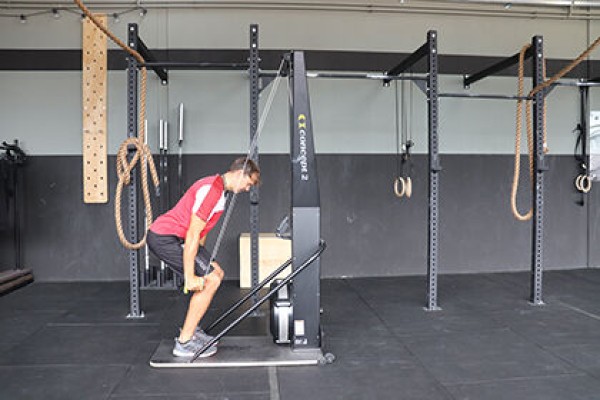
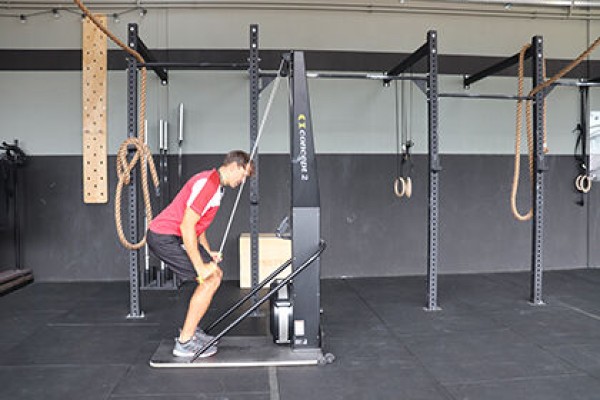





Working with the cross-country ski ergometer does not require any prior knowledge of winter sports, the technique is beginner-friendly and quick to learn. However, there are a few points to bear in mind: Firstly, stand with your feet slightly more than shoulder-width apart (how close you stand to the device is a matter of taste, although taller people usually prefer a greater distance in order to achieve a full arm extension at the starting point and therefore ultimately a longer stroke). The hands should also be just outside the shoulders when gripping the handles. As the handles of the device are attached to freely movable hinges, you can easily rotate them to your optimum position. The edges of the hand, including the little finger, should be placed on the thickened end of the handle, allowing more pressure to be applied. At the beginning of the pull, the entire body is stretched, only the arms remain slightly bent, the handles are now pulled downwards at an angle until the hands are just below the knees (a V-shaped curve, where the hands move sideways away from the body, is avoided). At the lowest point, the elbows are fully extended while the knees are minimally bent (comparable to the starting position of a jump). In the return phase, the body straightens up again completely, synchronised with the backswing of the arms. Lifting your heels off the ground is perfectly fine, especially at higher speeds.
Attention:
Do not turn every repetition into a squat, as this will tire your legs too quickly. Take a deep breath before each pull on the machine and keep the abdominal muscles under constant tension.
Lighten/Harden:
The intensity is controlled by adjusting the air valve. The higher the lever is moved on the scale (1-10), the wider the flap opens and the more air can flow into the bike. More air means more resistance in the initial phase of the pull (comparable to a higher pedalling resistance in the higher gears on a bicycle). It is important to find a setting at which a continuous and controlled pressure can be maintained. If the setting is too high, the air resistance initially has to be overcome with an excessively strong pull and the remaining range of motion "runs into nothing", which is a waste of energy. If you pay attention to the background noise, you will get a suitable indicator: the aim should be to achieve the smoothest possible whirring with only slight peaks in the initial phase of the pull. Most exercisers tend to over-optimise the resistance setting. As is so often the case, less is more; levels 6-7 work well for men and 4-6 for women, with exceptions for particularly heavy and strong athletes.
Variant:
The double pole technique is usually used for training, which means that both arms work in synchronisation with each other. The diagonal technique, in which the arms are used alternately, is less common but can be used as a variation. It achieves lower speeds than the simultaneous use of the arms, but is certainly suitable as an occasional training stimulus, which above all creates a healthy rotation of the spine and a strain on the lateral trunk muscles. The diagonal technique can also correct imbalances in unevenly developed back and arm muscles (e.g. after injuries).
1 cross-country ski ergometer
Cross-country ergometer (m: 125m - 10cal; w: 100m - 7cal)
Power
Individual work



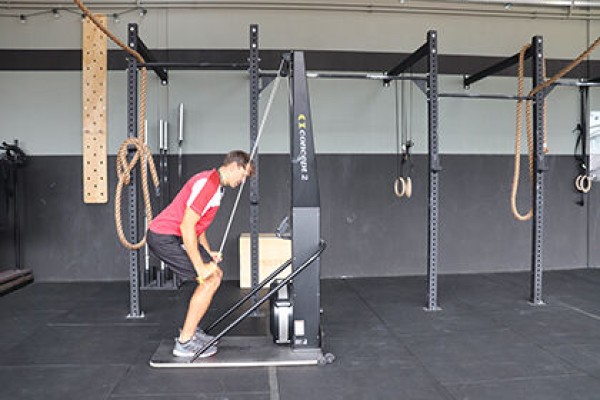

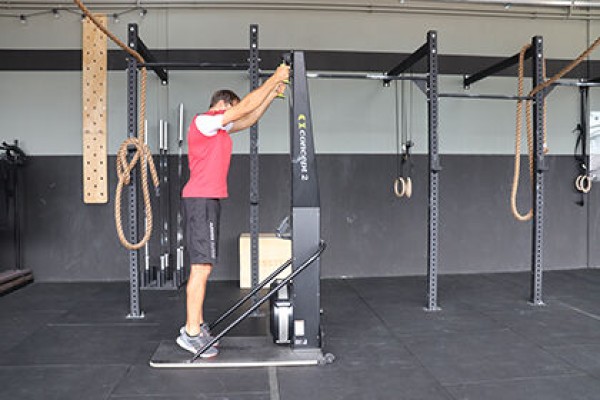
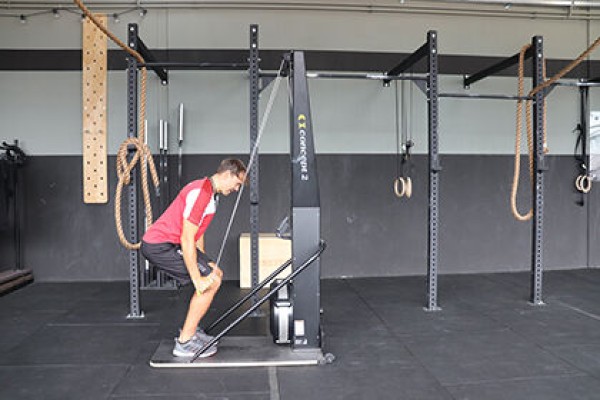


Working with the cross-country ski ergometer does not require any prior knowledge of winter sports, the technique is beginner-friendly and quick to learn. However, there are a few points to bear in mind: Firstly, stand with your feet slightly more than shoulder-width apart (how close you stand to the device is a matter of taste, although taller people usually prefer a greater distance in order to achieve a full arm extension at the starting point and therefore ultimately a longer stroke). The hands should also be just outside the shoulders when gripping the handles. As the handles of the device are attached to freely movable hinges, you can easily rotate them to your optimum position. The edges of the hand, including the little finger, should be placed on the thickened end of the handle, allowing more pressure to be applied. At the beginning of the pull, the entire body is stretched, only the arms remain slightly bent, the handles are now pulled downwards at an angle until the hands are just below the knees (a V-shaped curve, where the hands move sideways away from the body, is avoided). At the lowest point, the elbows are fully extended while the knees are minimally bent (comparable to the starting position of a jump). In the return phase, the body straightens up again completely, synchronised with the backswing of the arms. Lifting your heels off the ground is perfectly fine, especially at higher speeds.
Attention:
Do not turn every repetition into a squat, as this will tire your legs too quickly. Take a deep breath before each pull on the machine and keep the abdominal muscles under constant tension.
Lighten/Harden:
The intensity is controlled by adjusting the air valve. The higher the lever is moved on the scale (1-10), the wider the flap opens and the more air can flow into the bike. More air means more resistance in the initial phase of the pull (comparable to a higher pedalling resistance in the higher gears on a bicycle). It is important to find a setting at which a continuous and controlled pressure can be maintained. If the setting is too high, the air resistance initially has to be overcome with an excessively strong pull and the remaining range of motion "runs into nothing", which is a waste of energy. If you pay attention to the background noise, you will get a suitable indicator: the aim should be to achieve the smoothest possible whirring with only slight peaks in the initial phase of the pull. Most exercisers tend to over-optimise the resistance setting. As is so often the case, less is more; levels 6-7 work well for men and 4-6 for women, with exceptions for particularly heavy and strong athletes.
Variant:
The double pole technique is usually used for training, which means that both arms work in synchronisation with each other. The diagonal technique, in which the arms are used alternately, is less common but can be used as a variation. It achieves lower speeds than the simultaneous use of the arms, but is certainly suitable as an occasional training stimulus, which above all creates a healthy rotation of the spine and a strain on the lateral trunk muscles. The diagonal technique can also correct imbalances in unevenly developed back and arm muscles (e.g. after injuries).
1 cross-country ski ergometer
Skilanglauf-Ergometer (m: 2000m/2km - 160kal; w: 1600m/1.6km/1 Mile - 120kal)
Power
Individual work
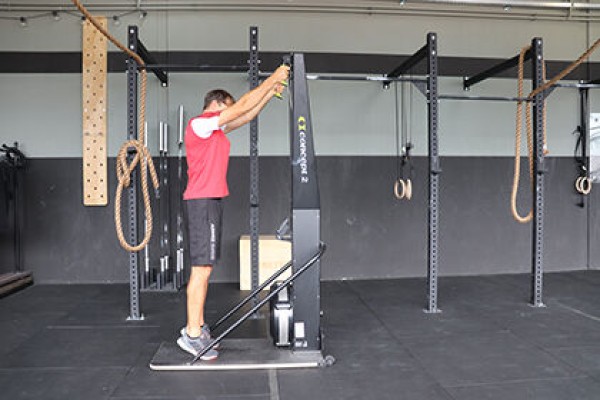

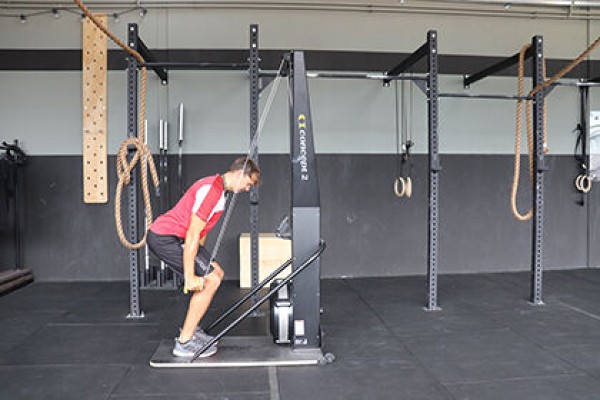
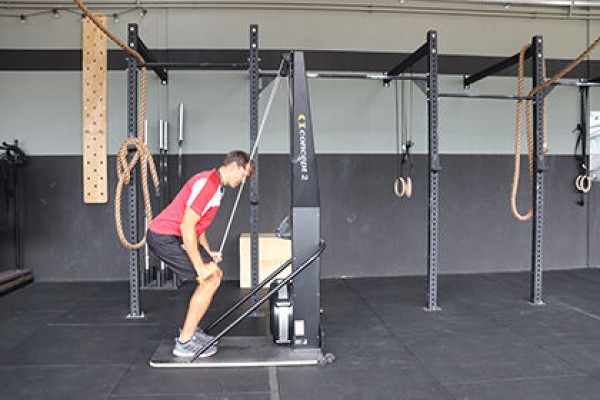
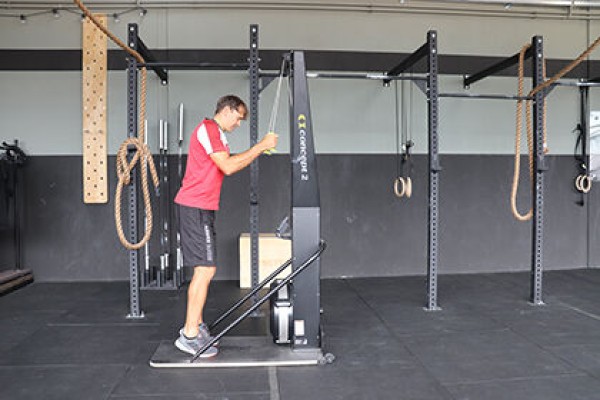

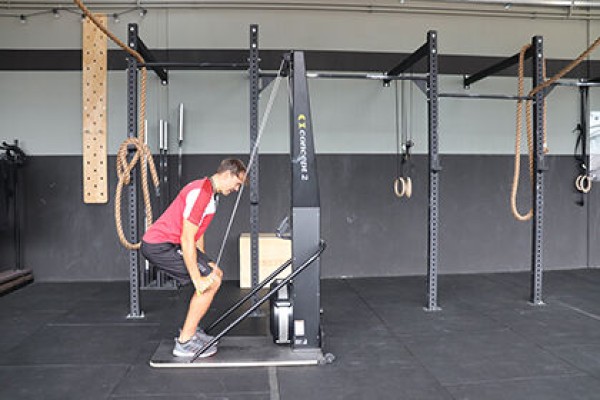
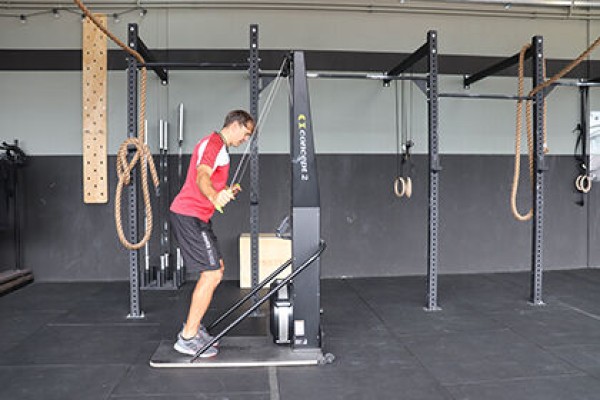

Working with the cross-country ski ergometer does not require any prior knowledge of winter sports, the technique is beginner-friendly and quick to learn. However, there are a few points to bear in mind: Firstly, stand with your feet slightly more than shoulder-width apart (how close you stand to the device is a matter of taste, although taller people usually prefer a greater distance in order to achieve a full arm extension at the starting point and therefore ultimately a longer stroke). The hands should also be just outside the shoulders when gripping the handles. As the handles of the device are attached to freely movable hinges, you can easily rotate them to your optimum position. The edges of the hand, including the little finger, should be placed on the thickened end of the handle, allowing more pressure to be applied. At the beginning of the pull, the entire body is stretched, only the arms remain slightly bent, the handles are now pulled downwards at an angle until the hands are just below the knees (a V-shaped curve, where the hands move sideways away from the body, is avoided). At the lowest point, the elbows are fully extended while the knees are minimally bent (comparable to the starting position of a jump). In the return phase, the body straightens up again completely, synchronised with the backswing of the arms. Lifting your heels off the ground is perfectly fine, especially at higher speeds.
Attention:
Do not turn every repetition into a squat, as this will tire your legs too quickly. Take a deep breath before each pull on the machine and keep the abdominal muscles under constant tension.
Lighten/Harden:
The intensity is controlled by adjusting the air valve. The higher the lever is moved on the scale (1-10), the wider the flap opens and the more air can flow into the bike. More air means more resistance in the initial phase of the pull (comparable to a higher pedalling resistance in the higher gears on a bicycle). It is important to find a setting at which a continuous and controlled pressure can be maintained. If the setting is too high, the air resistance initially has to be overcome with an excessively strong pull and the remaining range of motion "runs into nothing", which is a waste of energy. If you pay attention to the background noise, you will get a suitable indicator: the aim should be to achieve the smoothest possible whirring with only slight peaks in the initial phase of the pull. Most exercisers tend to over-optimise the resistance setting. As is so often the case, less is more; levels 6-7 work well for men and 4-6 for women, with exceptions for particularly heavy and strong athletes.
Variant:
The double pole technique is usually used for training, which means that both arms work in synchronisation with each other. The diagonal technique, in which the arms are used alternately, is less common but can be used as a variation. It achieves lower speeds than the simultaneous use of the arms, but is certainly suitable as an occasional training stimulus, which above all creates a healthy rotation of the spine and a strain on the lateral trunk muscles. The diagonal technique can also correct imbalances in unevenly developed back and arm muscles (e.g. after injuries).
1 cross-country ski ergometer
Cross-country ergometer (m: 200m - 16cal; w: 150m - 12cal)
Power
Individual work

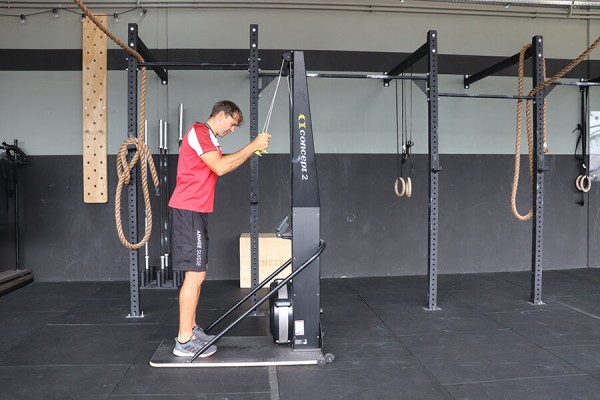

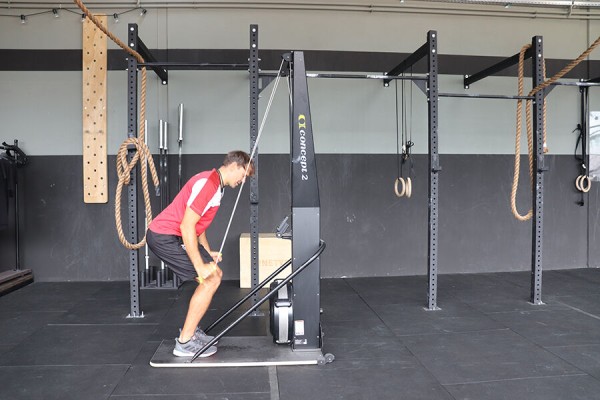
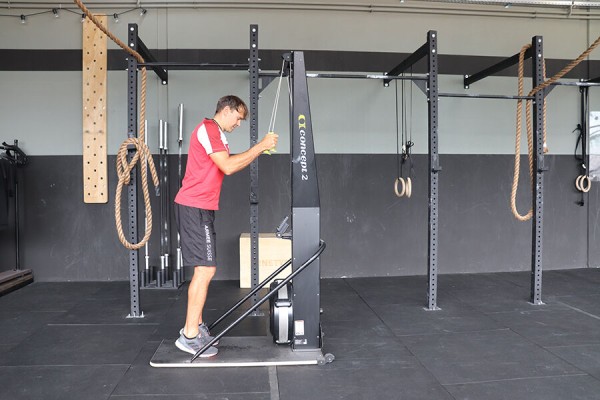

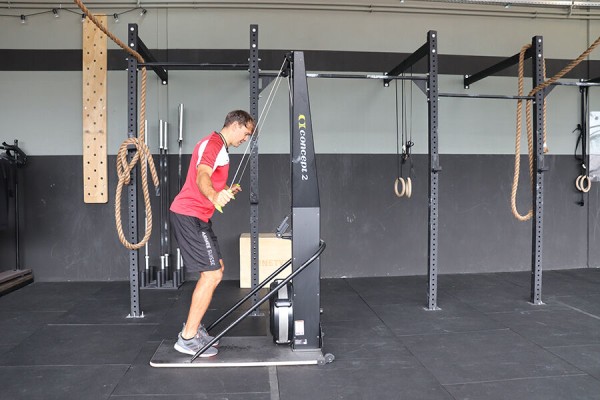

Working with the cross-country ski ergometer does not require any prior knowledge of winter sports, the technique is beginner-friendly and quick to learn. However, there are a few points to bear in mind: Firstly, stand with your feet slightly more than shoulder-width apart (how close you stand to the device is a matter of taste, although taller people usually prefer a greater distance in order to achieve a full arm extension at the starting point and therefore ultimately a longer stroke). The hands should also be just outside the shoulders when gripping the handles. As the handles of the device are attached to freely movable hinges, you can easily rotate them to your optimum position. The edges of the hand, including the little finger, should be placed on the thickened end of the handle, allowing more pressure to be applied. At the beginning of the pull, the entire body is stretched, only the arms remain slightly bent, the handles are now pulled downwards at an angle until the hands are just below the knees (a V-shaped curve, where the hands move sideways away from the body, is avoided). At the lowest point, the elbows are fully extended while the knees are minimally bent (comparable to the starting position of a jump). In the return phase, the body straightens up again completely, synchronised with the backswing of the arms. Lifting your heels off the ground is perfectly fine, especially at higher speeds.
Attention:
Do not turn every repetition into a squat, as this will tire your legs too quickly. Take a deep breath before each pull on the machine and keep the abdominal muscles under constant tension.
Lighten/Harden:
The intensity is controlled by adjusting the air valve. The higher the lever is moved on the scale (1-10), the wider the flap opens and the more air can flow into the bike. More air means more resistance in the initial phase of the pull (comparable to a higher pedalling resistance in the higher gears on a bicycle). It is important to find a setting at which a continuous and controlled pressure can be maintained. If the setting is too high, the air resistance initially has to be overcome with an excessively strong pull and the remaining range of motion "runs into nothing", which is a waste of energy. If you pay attention to the background noise, you will get a suitable indicator: the aim should be to achieve the smoothest possible whirring with only slight peaks in the initial phase of the pull. Most exercisers tend to over-optimise the resistance setting. As is so often the case, less is more; levels 6-7 work well for men and 4-6 for women, with exceptions for particularly heavy and strong athletes.
Variant:
The double pole technique is usually used for training, which means that both arms work in synchronisation with each other. The diagonal technique, in which the arms are used alternately, is less common but can be used as a variation. It achieves lower speeds than the simultaneous use of the arms, but is certainly suitable as an occasional training stimulus, which above all creates a healthy rotation of the spine and a strain on the lateral trunk muscles. The diagonal technique can also correct imbalances in unevenly developed back and arm muscles (e.g. after injuries).
1 cross-country ski ergometer
Cross-country ergometer (m: 250m - 20cal; w: 200m - 15cal)
Power
Individual work



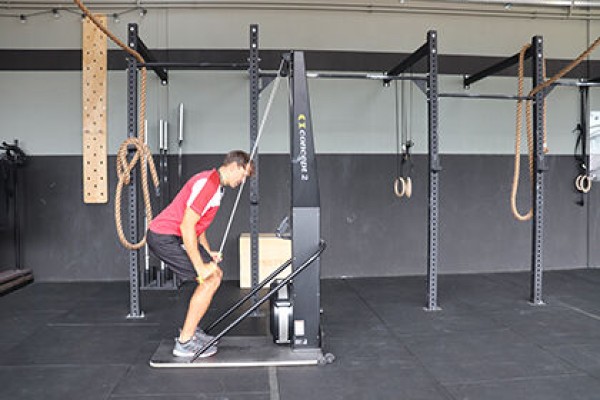
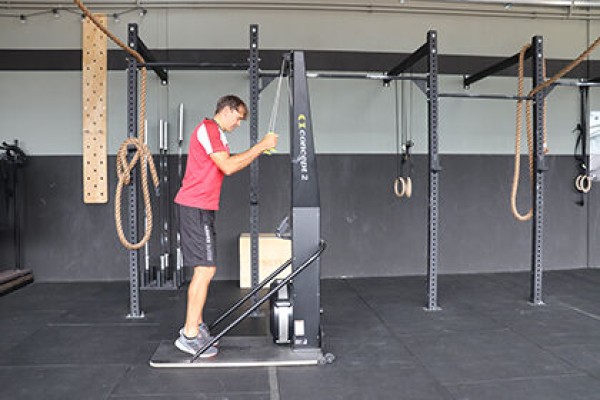

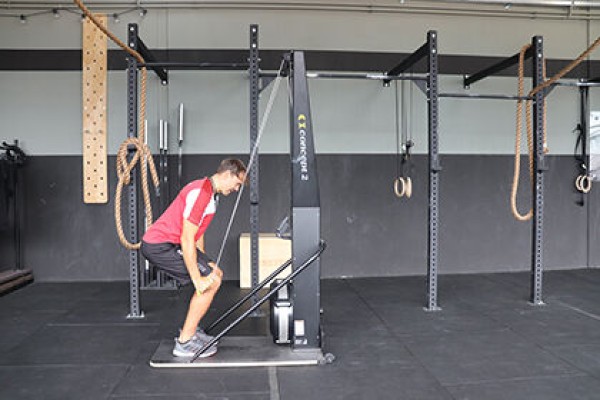

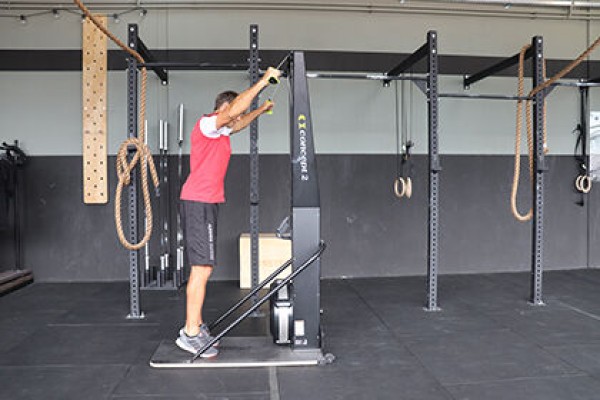
Working with the cross-country ski ergometer does not require any prior knowledge of winter sports, the technique is beginner-friendly and quick to learn. However, there are a few points to bear in mind: Firstly, stand with your feet slightly more than shoulder-width apart (how close you stand to the device is a matter of taste, although taller people usually prefer a greater distance in order to achieve a full arm extension at the starting point and therefore ultimately a longer stroke). The hands should also be just outside the shoulders when gripping the handles. As the handles of the device are attached to freely movable hinges, you can easily rotate them to your optimum position. The edges of the hand, including the little finger, should be placed on the thickened end of the handle, allowing more pressure to be applied. At the beginning of the pull, the entire body is stretched, only the arms remain slightly bent, the handles are now pulled downwards at an angle until the hands are just below the knees (a V-shaped curve, where the hands move sideways away from the body, is avoided). At the lowest point, the elbows are fully extended while the knees are minimally bent (comparable to the starting position of a jump). In the return phase, the body straightens up again completely, synchronised with the backswing of the arms. Lifting your heels off the ground is perfectly fine, especially at higher speeds.
Attention:
Do not turn every repetition into a squat, as this will tire your legs too quickly. Take a deep breath before each pull on the machine and keep the abdominal muscles under constant tension.
Lighten/Harden:
The intensity is controlled by adjusting the air valve. The higher the lever is moved on the scale (1-10), the wider the flap opens and the more air can flow into the bike. More air means more resistance in the initial phase of the pull (comparable to a higher pedalling resistance in the higher gears on a bicycle). It is important to find a setting at which a continuous and controlled pressure can be maintained. If the setting is too high, the air resistance initially has to be overcome with an excessively strong pull and the remaining range of motion "runs into nothing", which is a waste of energy. If you pay attention to the background noise, you will get a suitable indicator: the aim should be to achieve the smoothest possible whirring with only slight peaks in the initial phase of the pull. Most exercisers tend to over-optimise the resistance setting. As is so often the case, less is more; levels 6-7 work well for men and 4-6 for women, with exceptions for particularly heavy and strong athletes.
Variant:
The double pole technique is usually used for training, which means that both arms work in synchronisation with each other. The diagonal technique, in which the arms are used alternately, is less common but can be used as a variation. It achieves lower speeds than the simultaneous use of the arms, but is certainly suitable as an occasional training stimulus, which above all creates a healthy rotation of the spine and a strain on the lateral trunk muscles. The diagonal technique can also correct imbalances in unevenly developed back and arm muscles (e.g. after injuries).
1 cross-country ski ergometer
Cross-country ski ergometer (m: 375m - 30kal; w: 300m - 22kal)
Power
Individual work


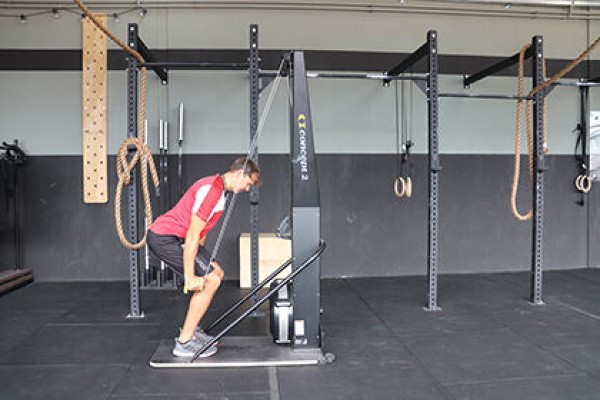

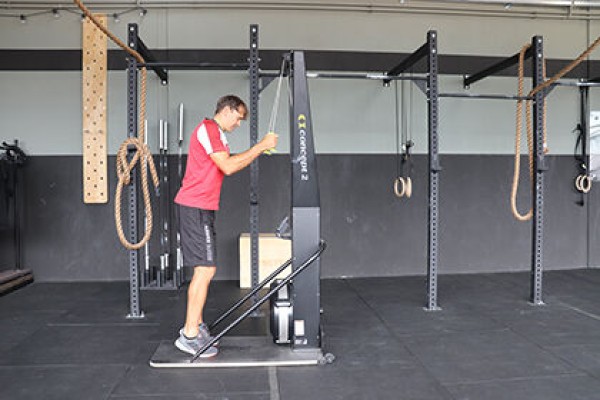


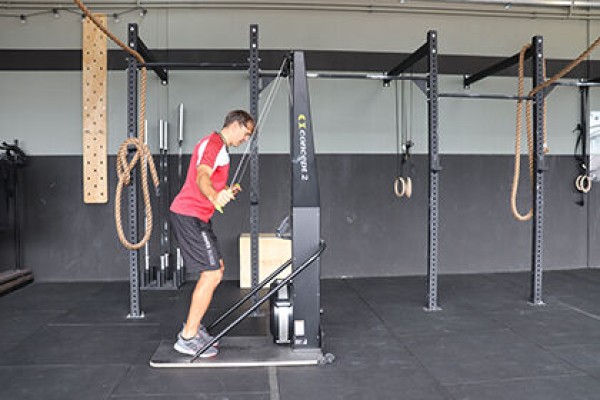

Working with the cross-country ski ergometer does not require any prior knowledge of winter sports, the technique is beginner-friendly and quick to learn. However, there are a few points to bear in mind: Firstly, stand with your feet slightly more than shoulder-width apart (how close you stand to the device is a matter of taste, although taller people usually prefer a greater distance in order to achieve a full arm extension at the starting point and therefore ultimately a longer stroke). The hands should also be just outside the shoulders when gripping the handles. As the handles of the device are attached to freely movable hinges, you can easily rotate them to your optimum position. The edges of the hand, including the little finger, should be placed on the thickened end of the handle, allowing more pressure to be applied. At the beginning of the pull, the entire body is stretched, only the arms remain slightly bent, the handles are now pulled downwards at an angle until the hands are just below the knees (a V-shaped curve, where the hands move sideways away from the body, is avoided). At the lowest point, the elbows are fully extended while the knees are minimally bent (comparable to the starting position of a jump). In the return phase, the body straightens up again completely, synchronised with the backswing of the arms. Lifting your heels off the ground is perfectly fine, especially at higher speeds.
Attention:
Do not turn every repetition into a squat, as this will tire your legs too quickly. Take a deep breath before each pull on the machine and keep the abdominal muscles under constant tension.
Lighten/Harden:
The intensity is controlled by adjusting the air valve. The higher the lever is moved on the scale (1-10), the wider the flap opens and the more air can flow into the bike. More air means more resistance in the initial phase of the pull (comparable to a higher pedalling resistance in the higher gears on a bicycle). It is important to find a setting at which a continuous and controlled pressure can be maintained. If the setting is too high, the air resistance initially has to be overcome with an excessively strong pull and the remaining range of motion "runs into nothing", which is a waste of energy. If you pay attention to the background noise, you will get a suitable indicator: the aim should be to achieve the smoothest possible whirring with only slight peaks in the initial phase of the pull. Most exercisers tend to over-optimise the resistance setting. As is so often the case, less is more; levels 6-7 work well for men and 4-6 for women, with exceptions for particularly heavy and strong athletes.
Variant:
The double pole technique is usually used for training, which means that both arms work in synchronisation with each other. The diagonal technique, in which the arms are used alternately, is less common but can be used as a variation. It achieves lower speeds than the simultaneous use of the arms, but is certainly suitable as an occasional training stimulus, which above all creates a healthy rotation of the spine and a strain on the lateral trunk muscles. The diagonal technique can also correct imbalances in unevenly developed back and arm muscles (e.g. after injuries).
1 cross-country ski ergometer
Cross-country ski ergometer (m: 500m - 40k; w: 400m - 30k)
Power
Individual work

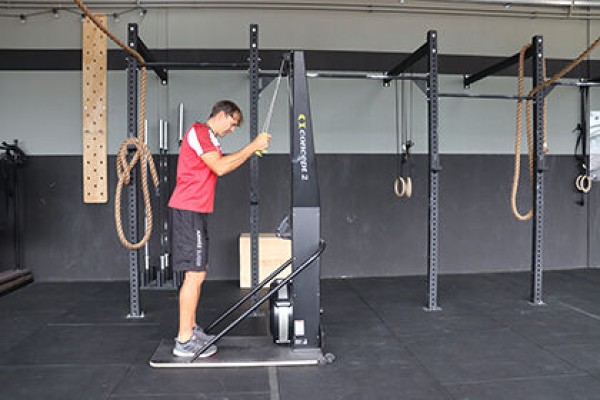

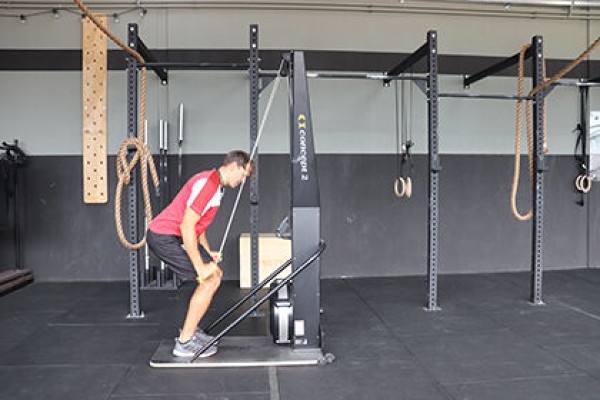


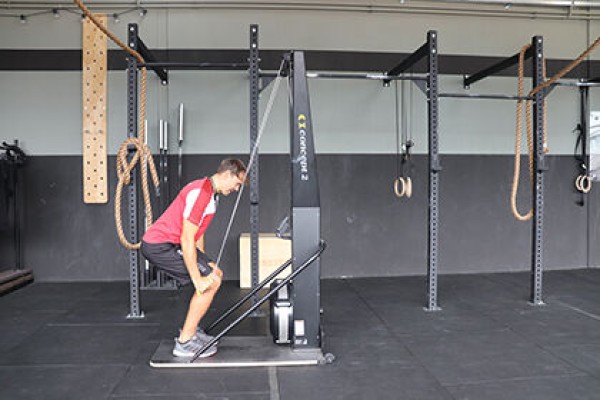
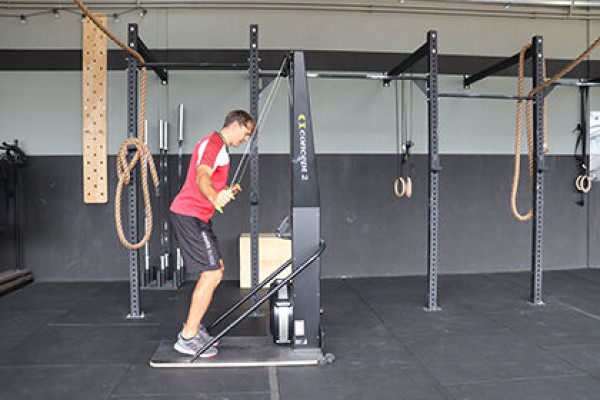

Working with the cross-country ski ergometer does not require any prior knowledge of winter sports, the technique is beginner-friendly and quick to learn. However, there are a few points to bear in mind: Firstly, stand with your feet slightly more than shoulder-width apart (how close you stand to the device is a matter of taste, although taller people usually prefer a greater distance in order to achieve a full arm extension at the starting point and therefore ultimately a longer stroke). The hands should also be just outside the shoulders when gripping the handles. As the handles of the device are attached to freely movable hinges, you can easily rotate them to your optimum position. The edges of the hand, including the little finger, should be placed on the thickened end of the handle, allowing more pressure to be applied. At the beginning of the pull, the entire body is stretched, only the arms remain slightly bent, the handles are now pulled downwards at an angle until the hands are just below the knees (a V-shaped curve, where the hands move sideways away from the body, is avoided). At the lowest point, the elbows are fully extended while the knees are minimally bent (comparable to the starting position of a jump). In the return phase, the body straightens up again completely, synchronised with the backswing of the arms. Lifting your heels off the ground is perfectly fine, especially at higher speeds.
Attention:
Do not turn every repetition into a squat, as this will tire your legs too quickly. Take a deep breath before each pull on the machine and keep the abdominal muscles under constant tension.
Lighten/Harden:
The intensity is controlled by adjusting the air valve. The higher the lever is moved on the scale (1-10), the wider the flap opens and the more air can flow into the bike. More air means more resistance in the initial phase of the pull (comparable to a higher pedalling resistance in the higher gears on a bicycle). It is important to find a setting at which a continuous and controlled pressure can be maintained. If the setting is too high, the air resistance initially has to be overcome with an excessively strong pull and the remaining range of motion "runs into nothing", which is a waste of energy. If you pay attention to the background noise, you will get a suitable indicator: the aim should be to achieve the smoothest possible whirring with only slight peaks in the initial phase of the pull. Most exercisers tend to over-optimise the resistance setting. As is so often the case, less is more; levels 6-7 work well for men and 4-6 for women, with exceptions for particularly heavy and strong athletes.
Variant:
The double pole technique is usually used for training, which means that both arms work in synchronisation with each other. The diagonal technique, in which the arms are used alternately, is less common but can be used as a variation. It achieves lower speeds than the simultaneous use of the arms, but is certainly suitable as an occasional training stimulus, which above all creates a healthy rotation of the spine and a strain on the lateral trunk muscles. The diagonal technique can also correct imbalances in unevenly developed back and arm muscles (e.g. after injuries).
1 cross-country ski ergometer
Cross-country ski ergometer (m: 750m - 60k; w: 600m - 45k)
Power
Individual work
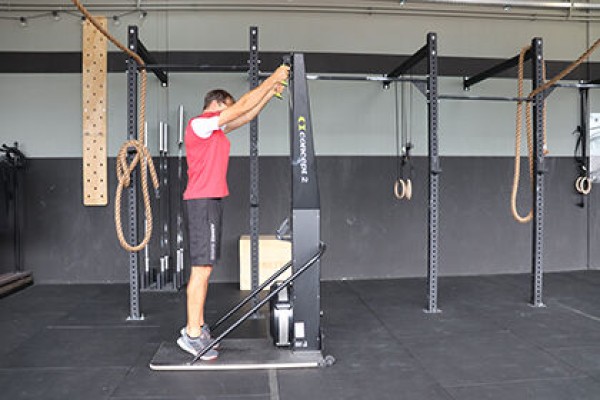


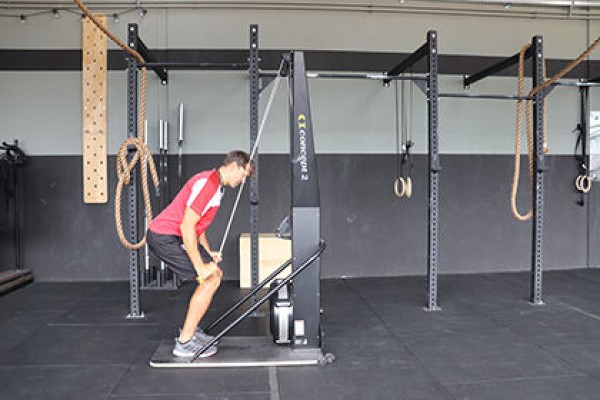
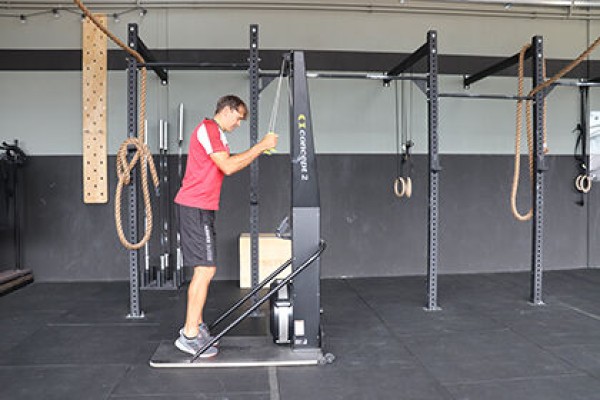
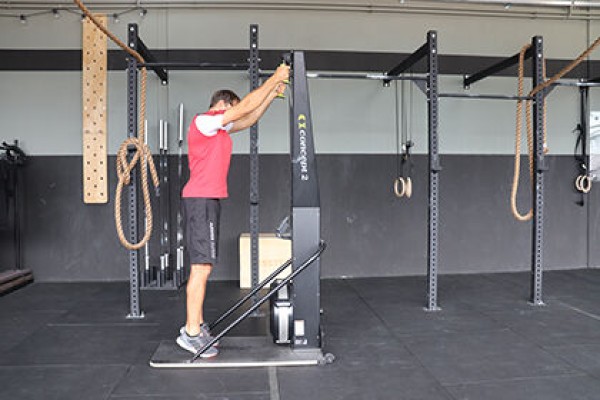



Working with the cross-country ski ergometer does not require any prior knowledge of winter sports, the technique is beginner-friendly and quick to learn. However, there are a few points to bear in mind: Firstly, stand with your feet slightly more than shoulder-width apart (how close you stand to the device is a matter of taste, although taller people usually prefer a greater distance in order to achieve a full arm extension at the starting point and therefore ultimately a longer stroke). The hands should also be just outside the shoulders when gripping the handles. As the handles of the device are attached to freely movable hinges, you can easily rotate them to your optimum position. The edges of the hand, including the little finger, should be placed on the thickened end of the handle, allowing more pressure to be applied. At the beginning of the pull, the entire body is stretched, only the arms remain slightly bent, the handles are now pulled downwards at an angle until the hands are just below the knees (a V-shaped curve, where the hands move sideways away from the body, is avoided). At the lowest point, the elbows are fully extended while the knees are minimally bent (comparable to the starting position of a jump). In the return phase, the body straightens up again completely, synchronised with the backswing of the arms. Lifting your heels off the ground is perfectly fine, especially at higher speeds.
Attention:
Do not turn every repetition into a squat, as this will tire your legs too quickly. Take a deep breath before each pull on the machine and keep the abdominal muscles under constant tension.
Lighten/Harden:
The intensity is controlled by adjusting the air valve. The higher the lever is moved on the scale (1-10), the wider the flap opens and the more air can flow into the bike. More air means more resistance in the initial phase of the pull (comparable to a higher pedalling resistance in the higher gears on a bicycle). It is important to find a setting at which a continuous and controlled pressure can be maintained. If the setting is too high, the air resistance initially has to be overcome with an excessively strong pull and the remaining range of motion "runs into nothing", which is a waste of energy. If you pay attention to the background noise, you will get a suitable indicator: the aim should be to achieve the smoothest possible whirring with only slight peaks in the initial phase of the pull. Most exercisers tend to over-optimise the resistance setting. As is so often the case, less is more; levels 6-7 work well for men and 4-6 for women, with exceptions for particularly heavy and strong athletes.
Variant:
The double pole technique is usually used for training, which means that both arms work in synchronisation with each other. The diagonal technique, in which the arms are used alternately, is less common but can be used as a variation. It achieves lower speeds than the simultaneous use of the arms, but is certainly suitable as an occasional training stimulus, which above all creates a healthy rotation of the spine and a strain on the lateral trunk muscles. The diagonal technique can also correct imbalances in unevenly developed back and arm muscles (e.g. after injuries).
1 cross-country ski ergometer
Sprinting/throwing an object
Power
Individual work

Purpose
Training and testing of the throwing technique
Additional equipment
5 HG 85 throwing gun
Starting position
lying down, Stgw with empty magazine
Procedure
Sprint 50 m into a throwing position (target time 15 s)
5 throws from different throwing distances
Conditions
4 hits and 3 different freely selectable throwing distances
Notes
If no realistic HG targets are available, marked target areas can also be used (e.g.
for reasons of efficiency, several throwers should be able to practise at the same time.
with an increased routine, the requirements in terms of throwing distance should be increased.
Material per participant: Tenue CNM
Additional material: 6 G-discs with posts, 3 fanjons, 2 red/white marking tapes, 2 boxes with 16 HG 85 clay pellets
Sprinting
Power
Individual work
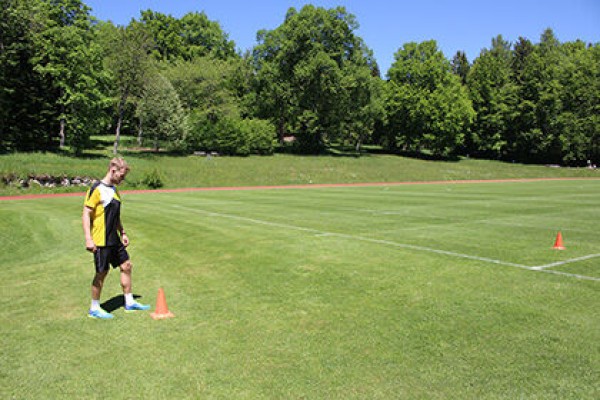
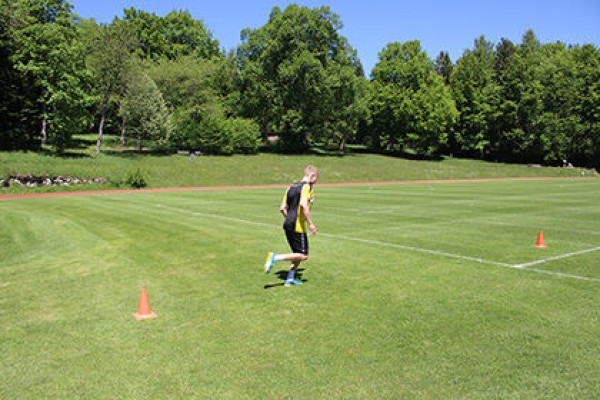
Cover a given distance (between 10-20 metres) as quickly as possible/at a sprint (if necessary, shuttle back and forth between the markers several times).
Lighten:
Lower speed.
Harden:
Higher speed.
Variant:
Do not sprint but change your gait between the markers (e.g. backwards, on all fours, crawling, etc.).
2 marinating cones/caps/colouring sticks